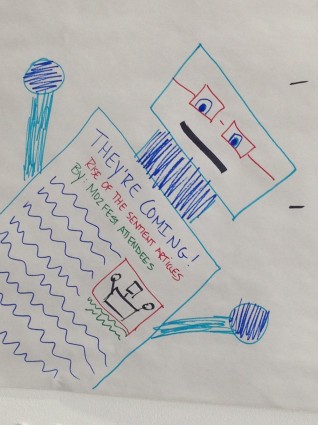
On the first day of MozFest, I went to an intriguing session called “Rise of the Sentient Articles.” Led by ProPublica’s Sisi Wei and Ryann Jones, the session encouraged participants to brainstorm the future of news powered by algorithms.
What if articles modified themselves based on an individual reader’s needs? What if, rather than building news applications and interactive graphics that rely on user input, the content was automatically restructured or personalized based on where or what a reader was doing?
It’s an interesting concept, and I was keen to contribute to the session and brainstorm new ideas.
Wei and Jones noted their session had a “nerdy” origin – Wei drew inspiration from Dungeons & Dragons (D&D), a fantasy tabletop role-playing game where players embark on adventures mediated by a referee and storyteller known as the Dungeon Master, who responds to changes in the game. She wanted to apply the concepts from D&D to news articles, the format of which has “barely changed” despite the rise of interactivity in other areas of news.
After introducing a few examples of content personalization, such as ProPublica’s investigation Dollars for Docs and talking briefly about Tangle, a JavaScript library for creating reactive documents, Wei and Jones asked participants to brainstorm the following questions:
- What about articles can be better?
- What stories would sentient articles make sense for?
- How do we ask for user information without being intrusive?
Participants first tackled the definition and goals of a “sentient article.” Rather than navigations and walkthroughs through a feature, “sentient” journalism targets the article’s internal structure and formation, such as quotes, images, colors, tone, etc. Ideally, there should be minimal interaction for the user while still maintaining their privacy and producing a rich news experience.
A simple starting point could be taking the article’s text beyond highlighting – providing source material behind words or phrases, crafting inline multimedia experiences or including the “director’s cut” for interviews. These are relatively low-cost ways to contextualize articles, as much of the work has already been done in the reporting process. Other article components that could be made interactive include personalized data comparisons, anecdotes and even headlines. Higher fidelity applications can make use of an individual’s physical environment, possibly tapping into mobile sensors to tailor content on topics such as pollution or transportation.
Much of the conversation centered on creating the ‘Goldilocks’ article based on a reader’s interest or prior knowledge. For example, readers coming to a story having read ten or more articles on Ebola may not require as much contextualization of the disease and epidemic as a reader who hasn’t previously read any related stories. This information can inform both the length and content of an article, automatically adjusting the complexity of terminology or “depth.”
Participants brainstormed ways to dynamically update articles as they are read, possibly by adding quick checkpoints and quizzes that ask for peoples’ level of interest and understanding. Is the subject matter too dense, too simple, or just right? Are people interested, bored, or passive? Taking answers from these questions, the subsequent content can be modified on the fly.
As with explorations of any new frontier, sentient journalism is a balancing act. How do we strike a compromise between privacy and personalization? Completeness and redundancy? Do we replace or add content? Will we lose readers by branching the same article? Is sentient journalism more suited to visualization or prose? How might we balance the energy to create a sentient article and the degree to which users will want to interact with it?
These questions are for the community to answer through experimentation and application.
“The hope is to have the first live example of a sentient article by NICAR,” Wei and Ryan said. By building such an article, they hope to learn the difficulties and problems in the process. By releasing the source code, they hope to elicit enough feedback to iterate and create the original sentient article, version 2.0.
I thought the session was an exciting first step in thinking about ways to use more data, sensors and context to curate and personalize news. Since this was the first discussion around sentient journalism, I’m excited to see how the community shapes its definition and application.
About the author






